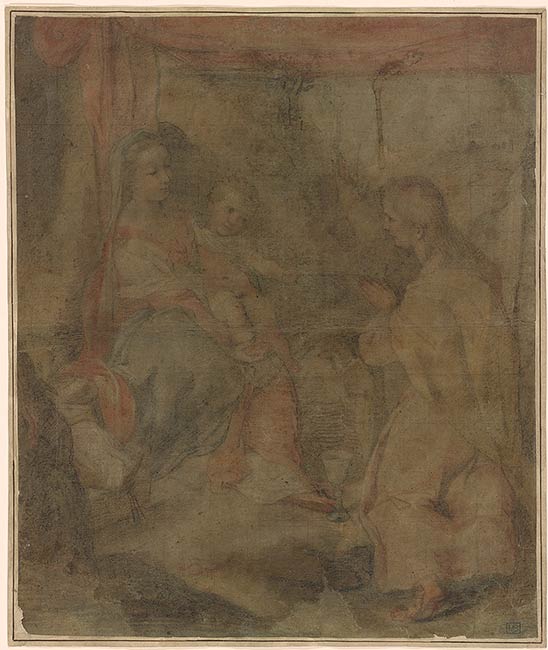
Barocci was born in Urbino and received his initial training there but spent two formative sojourns in Rome, the first for four years around 1550 and the second in the early 1560s. Working in the orbit of Taddeo and Federico Zuccaro, he soon attained some fame and success, but in 1563 he suffered a grave illness, perhaps after eating a salad poisoned by a rival painter. He returned to Urbino and would remain there for the rest of his career.
Although aware of the drawing practice of the Zuccaro brothers and other Roman painters, Barocci developed a complex preparatory process all his own. He was by all accounts a cerebral painter, but the lingering effects of his illness—which supposedly left him unable to paint for more than a few hours each day—may have led him to devise the complicated method through which he worked up compositions in a series of elaborate steps, with drawings made at various scales in relationship to the final painting. He was also among the first artists to make extensive use of pastels, or manufactured colored chalks, particularly for studies of the principal heads and limbs of his paintings (see, for example, 1986.85).1
Barocci returned from Rome to Urbino in 1563. When he finally recovered from his illness, sometime around 1565, his first painting was the Virgin and Child with St. John the Evangelist, better known as the Madonna di San Giovanni. A votive painting thanking the Virgin for his recovery, the small altarpiece was first installed in the small Capuchin chapel at Crocicchia outside Urbino; it was later transferred to the Capuchin convent of San Francesco in Urbino and is today in the Galleria Nazionale delle Marche.2
There are only minor differences between the painting and the Morgan compositional drawing, and it has occasionally been suggested that the latter is merely a copy after the finished work. Yet despite its poor condition—which makes reading the drawing difficult—the work already demonstrates key elements of Barocci’s distinctive drawing practice and must be his own. As has often been noted, for example, this is the earliest drawing to use the colored chalks so typical of Barocci, although he would generally use them for detailed studies rather than compositional drawings. Moreover, the now-faint 35-millimeter squaring of the Morgan drawing matches that of a sheet in the Uffizi with two studies for the figure of St. John (Gabinetto Disegni e Stampe degli Uffizi, Florence, inv. 11373), and those figure studies match this in size. It would have been typical of Barocci to have made multiple sketches at the same scale for a single figure, with only minor variations in the fall of the drapery. Conversely, it is impossible to imagine that someone copying the altarpiece would have matched both the figure size and the squaring to Barocci’s studies.
The Morgan drawing was, however, surely retouched at some later moment. There are a number of rips, patches, and repairs. Even faded, the colors match those of the painting, suggesting that, although strengthened, they were part of Barocci’s original drawing.3 One scenario that might account for the reworking and for some of the unusual aspects of this drawing is that at the height of Barocci’s fame—some twenty years after he painted the Madonna di San Giovanni—Matthias Greuter and Raffaele Guidi, two artists based in Rome, made reproductive prints of the work. It seems plausible that Barocci was asked to provide them with a model and that he sent the printmakers some of his drawings. As evidence for this, it might be noted that the eagle that is St. John’s iconographic attribute is absent in the Morgan drawing and looks up toward the saint in the painting but is turned away from him both in the Uffizi drawing and in the reproductive prints.
—JJM
Footnotes:
- On Barocci’s preparatory process, especially with respect to drawings at multiple scales, see Marciari and Verstegen 2008; Ian Verstegen is also preparing a book-length study of this issue. For a more general recent introduction to Barocci as a draftsman, see Babette Bohn’s essay in St. Louis and London 2012–13, 33–69.
- On the painting, see Emiliani 2008, no. 16.
- In addition to the reworking of the drawing, the work was also at some point varnished or covered in wax so that the drawing could be exhibited like a painting, but this has caused it to darken over time.
Watermark: none visible through lining.
The drawing is a late compositional study for the painting Virgin and Child with Saint John the Evangelist in a Landscape (Madonna di San Giovanni), executed by Barocci ca. 1565 as a votive gift for the church of the Capuchin Fathers at Crocicchia, and now in the Galleria Nazionale delle Marche at Urbino. The drawing is the earliest connected pastel study by Barocci to survive; the technique of drawing in colored chalk may have resulted from the exposure to Correggio's drawings.
Inscribed on verso of mount, in graphite, "201/008; No. 9 Francesco Vanni" (cancelled); beneath this, in graphite, "Barocci"; in blue crayon, "6."
Rhoda Eitel-Porter and and John Marciari, Italian Renaissance Drawings at the Morgan Library & Museum, New York, 2019, no. 113.
Selected references: Cleveland and New Haven 1978, no. 15; Fellows Report 19 1981, 175; McCullagh 1991, 55-56; Verstegen 2003, 378; Emilianiq 2008, 1: no. 16:2; St. Louis and London 2012-13, 68n124.
Ryskamp, Charles, ed. Nineteenth Report to the Fellows of the Pierpont Morgan Library, 1978-1980. New York : Pierpont Morgan Library, 1981, p. 175.
